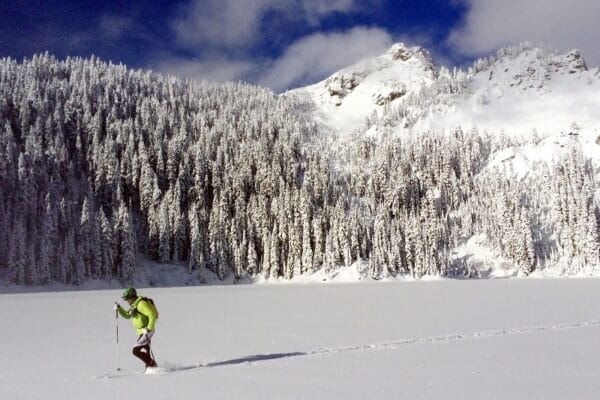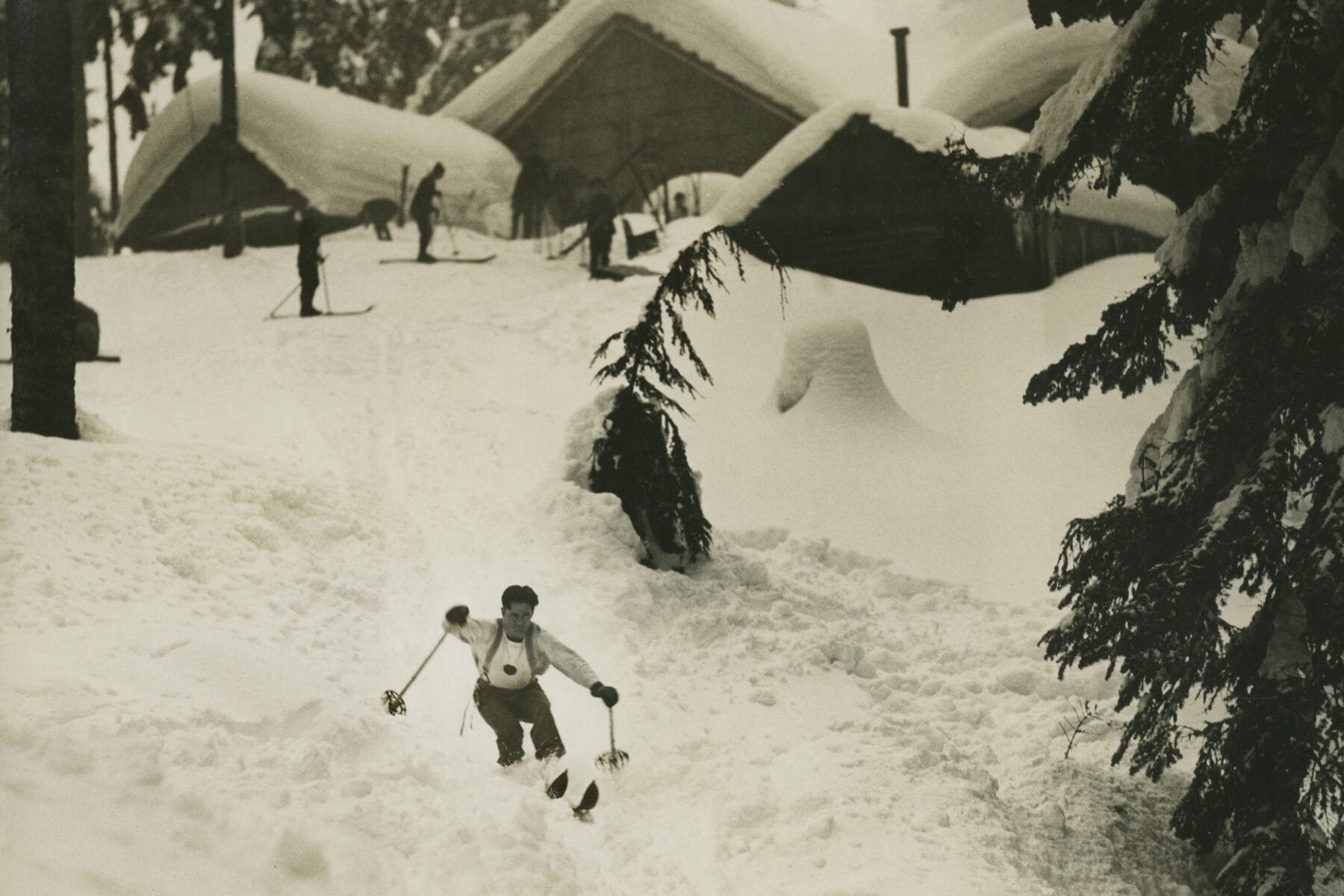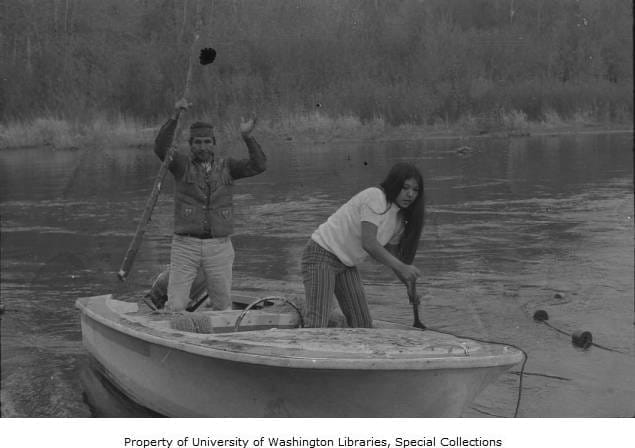Mountaineers Patrol Races – “The Nation’s Longest and Hardest Race” (Part 2)
Click here to read part 1 of the story of the Patrol Races if you missed it!
The year 1936 was a significant one for The Mountaineers. At the Pacific Northwest Downhill and Slalom Championships at Mt. Hood, Wolf Bauer was 3rd in the downhill, 14th in the slalom, finishing 7th in the Combined, competing against the best skiers in the Northwest. The club’s 1936 Patrol Race, open only to members, was won by the team of Wolf Bauer, Chet Higman and Bill Miller in a new record time of 4 hours 37 minutes, 23 seconds, nearly an hour faster than the old record of 5:32. This record lasted 80 years, until after the race was restarted in 2014.
In 1936, the Mountaineers joined the Pacific Northwest Ski Association (PNSA), and held the first Open Patrol Race, where patrols from any club affiliated with the PNSA could participate. Five patrols entered, and for the first time, the race ran from Snoqualmie Lodge to Meany Ski Hut. A Ski Patrol Trophy was awarded to the winning team, engraved with names of the winning patrol, held by the club sponsoring the team the following year. Members of the winning patrol received medals.
The Seattle Times of March 13, 1936, said the Patrol race was the “nation’s longest and hardest ski race.” No one under 20 could enter, as the course was considered too severe for youngsters, and participants had to show they passed a medical examination. The course went through the “high, gleaming ridges of the Cascade Range;…from the low to the moderately high, back to the low, up to the high, and then sweeps down. You push the middle valve here!…But you can’t realize what’s coming out until you’ve made the trip. It’s marvelous.”
The 1936 race was held in warm weather and 15 inches of new snow, making it a competition for “the strongest, and heaven help the unfortunate trail-breakers, who must make an eighteen-mile trail,” according to the Seattle Times. The adverse weather demonstrated the necessity of the equipment required for the race. The course could be done in five hours in good conditions, but adverse conditions may require a nighttime bivouac in the snow.
The Seattle Ski Club patrol of Roy Nerland, Howard Dalsbo and Ole Tierdal won the first Open Patrol Race – “a grueling haul designed only for the best cross-country racers of each club.” Dalsbo pulled a tendon in his knee ten miles from Martin, but “gamely finished.” The team found the course “with its long climbs, wooded and open runs, steep pitches and short schusses” to its liking, as it finished in 4:50:39, beating the next team by four hours, according to the Seattle Times.
The Everett Mountaineers were disqualified as one member fell sick and returned to the start, and only two finished. The Washington Ski Club (with Hans-Otto Giese) was disqualified after a member broke a ski and borrowed an emergency ski tip from another team – no patrol could accept assistance from another patrol. The Seattle Mountaineers (with Wolf Bauer) was disqualified when a member became ill and turned around to return to Snoqualmie. The team went on without him, but he got better and went on to Martin, finishing well behind the others. All patrol members had to finish within one minute of each other. It was thought the College of Puget Sound patrol turned back, but they reached Martin nine hours after starting, making a “leisurely trip,” and placed second by adhering to the rules and finishing together. In future races, a pair of skiers will leave the Lodge with the last patrol and act as rear guide. If a patrol has not reached a check-in post in a reasonable time, it will be turned back. Future Patrol races were sanctioned by the PNSA as Pacific Northwest Patrol Race Championships. Seattle Times, March 16, 1936.
In 1937, teams started at five minute intervals beginning at 9:00 am because of the lateness some teams finished the prior year. Teams not past the half-way mark by 2:00 pm would be turned back. The race was won by The Mountaineers (Wm. A. Degenhardt, Scott Edson and Sigurd Hall) in 5:12:5, on a crusty course. Sigurd Hall went on to become one of the Northwest’s best alpine racers, placing third the 1940 National Four-Way Championships held in Washington, behind the great Alf Engen and his brother Sverre. Hall tragically died in the 1940 Silver Skis Race on Mt. Rainier when he hit some rocks in a fogbank.

Seven patrol teams entered in the 1938 Pacific Northwest Patrol Race Championships. According to the Seattle Times of February 7, 1938:
“No audience will watch them, for their course doesn’t run past any grandstand; but a small group at the finish will cheer six there-man ski teams…They’ll have earned it. To reach Martin, twenty miles from their start at Snoqualmie Lodge…they must climb several times, to heights of 1,000 to 3,000 feet. They’ll be downhill trails, of course…eleven miles in all. But they come dearly, when the teams are slugging their way along as fast as wind and muscle will permit.”
The race on “twenty miles of ice,” was won by The Mountaineers (Scott Edson, Sigurd Hall and Art Wilson) in 4:57:45. Two patrols failed to finish because of the difficult conditions. The Seattle Times of February 18,1939, said the race was
“slightly crazy to the lay skier…The Patrol Race breeds weather-wise and snow-wise skiers. They are required by the rules of the race to carry all the equipment necessary for any unexpected but enforced delay in their travel; an ax; food; rope and supplies; an extra array of clothing. But to simplify their crossing of the Cascades’ rugged slope; they must also have snow-sense; how to wax for a twenty-mile journey; how to beat the dickens, but conserve enough strength for a stanch finish, in other words, how to conduct themselves in the mountains.”
Seven patrols entered the 1939 race, which was won by the Seattle Ski Club (Sigurd Hall, Bert Mortensen and Roy Nerland) in 4:59:20. Cheers were given to the trail-breakers who proceeded the teams by an hour and a half, and made the winners’ speedy run possible. Seattle Times, February 21, 1939.
“A skier naturally travels faster on an already-broken trail; and by the time [the trail breakers] reached the summit of Dandy Pass and were on their way down, the racers were keening along, right back of them. The trail-breakers punched along, fast as they could. But here came the Seattle Ski Club team, the eventual winner. They overtook the trail-breakers five minutes from Martin – and broke the rest of its trail in.”
Seven teams entered the 1940 Patrol Race, even though most Northwest skiers were “downhill-slalom minded and adverse to getting off the beaten practice slopes.” The Washington Alpine Club team won the race over a mushy course of 20 miles of rough going. Seattle P.I., March 2, 1940.
The 1941 Mountaineers Patrol race attracted five teams, including two from the Army’s 15th Infantry who were training on Mt. Rainier (one of which finished second). All five teams finished within one hour’s time of each other, but two were disqualified when they got off course at Stampede and approached Meany Ski Hut by the wrong route. The same Washington Alpine Club team won for the second year in a row. According to the Seattle Times of March 10, 1941:
“It was a nice day for a picnic, but not for eighteen long miles of langlauf…It was icy all the way except for a few open slopes which had been hit by sun, and they were few and far too few…Legs were “shot” when the patrols reached the Meany Lane run to the finish line, check turns were difficult on the icy going, and most of the tired patrol members staged a sprawling act of the officials gathered at Meany Ski Hut.”
In June 1941, The Mountaineers’ Board voted to discontinue the patrol races due to a lack of interest.

The Mountaineers restarted its classic Patrol Races in 2014, led by Nigel Steere assisted by Lowell Skoog, and has run them when snow conditions permit. The results are summarized in Lowell Skoog’s website, Alpenglow.org. The modern Patrol Race has become so popular that entries are now selected by lottery because of the demand to compete. The organizers hope the race will inspire modern skiers for many years to come.
BIBLIOGRAPHY
The Mountaineer, December 1936, published by The Mountaineers; Mountaineers’ Application to join the Pacific Northwestern Ski Association, 1936; Kjeldsen, Jim, The Mountaineers: A History, The Mountaineers, 1998; Lundin, John W., “Mountaineers Patrol Races at Snoqualmie Pass: A Grand Tradition Revisited,” Historylink Essay 10755; Skoog, Lowell, alpenglow.org/ski-history/subjects/P-info.html#patrol-race; Skoog, Retro Rewind: Wolf Bauer, a Wonderful Life: 1912-2016.
John is a lawyer, historian and author who has written extensively about Washington and Idaho history. He is a founding member of the Washington State Ski & Snowboard Museum, and his essays about Washington ski history are published on Historylink.org, the on-line encyclopedia of Washington History, and the Central Washington University website for local authors, https://digitalcommons.cwu.edu/local_authors/. He is the author of four books: Early Skiing on Snoqualmie Pass (2017)*: Sun Valley, Ketchum and the Wood River Valley (2020)**; Skiing Sun Valley: a History from Union Pacific to the Holdings (2020)*; and Ski Jumping in Washington: a Nordic Tradition (2021).
* Skade book award winner from International Ski History Association; **Skade honorable mention.





